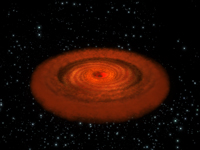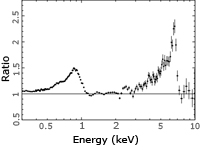XMM-Newton probes the inner mechanisms of Active Galactic Nuclei
27 May 2009
Spectral analysis of XMM-Newton observations of 1H0707-495 (a narrow line Seyfert 1 galaxy) has for the first time revealed the presence of broad K and L iron lines. The simultaneous detection reveals hitherto unobserved details of the geometry and dynamics of the supermassive black hole at the centre of this galaxy. This is reported by Fabian et al in the 28 May 2009 issue of Nature.
 |
|
Figure 1. Artist's impression of a supermassive black hole accreting matter. Credit: ESA |
Over the past 15 years mounting evidence has been accumulated about the presence of supermassive black holes at the centre of almost all nucleated galaxies. About 10% of these galaxies are known to be strong X-ray emitters. In these so-called Active Galactic Nuclei the central black hole accretes a significant amount of matter from the surrounding galaxy. The dynamics of such systems is such that the matter flowing towards the black hole forms an accretion disk, where the gravitational potential is transformed into electromagnetic energy through the viscosity of the disk itself.
X-ray observations reveal the physics of extreme conditions
Under these conditions the disk is expected to become a source of optical and ultraviolet photons, and the X-ray emission is thought to be due to the Compton scattering of these photons in a hot corona surrounding the disk. The study of the X-ray emission, believed to originate close to the black hole, is therefore a potent means to understand the physics and the geometry at work in these extreme conditions.
According to the models, the X-ray emission occurs in flares in active regions across the corona. The flares irradiate the accretion disk, that is relatively cold, and cause the emergence of a 'reflected' component. The Compton scattering of soft photons naturally gives rise to X-rays with a rather hard power law spectrum. Depending on the ionization conditions in the disk, the irradiation can give rise to K fluorescence lines in the most abundant materials in the disk, usually assumed to be iron. Again depending on the physical conditions of the matter in the disk, L lines are also possible. Both lines are intrinsically rather narrow, but the strong gravitational field and the quickly rotating disk broaden and distort the lines in a characteristic manner reminiscent of the physical and dynamical conditions around the black hole.
Spectral analysis probes the inner mechanisms of AGN
 |
|
Figure 2. Broad K and L iron lines detected in 1 H0707-495. Image courtesy of A. Fabian |
The authors argue that the same signature should be visible in similar sources. A systematic study of the reflected component in this type of source under different physical and dynamic conditions will help fix the details of the model, and significantly contribute to the understanding of the way supermassive black holes work.
Reference publication:
Fabian, A.C. et al., "The detection of Broad Iron K and L line emission in the Narrow-Line Seyfert 1 Galaxy 1H 0707-495 using XMM-Newton", Nature 459, 540-542, 28 May 2009, doi:10.1038/nature08007

